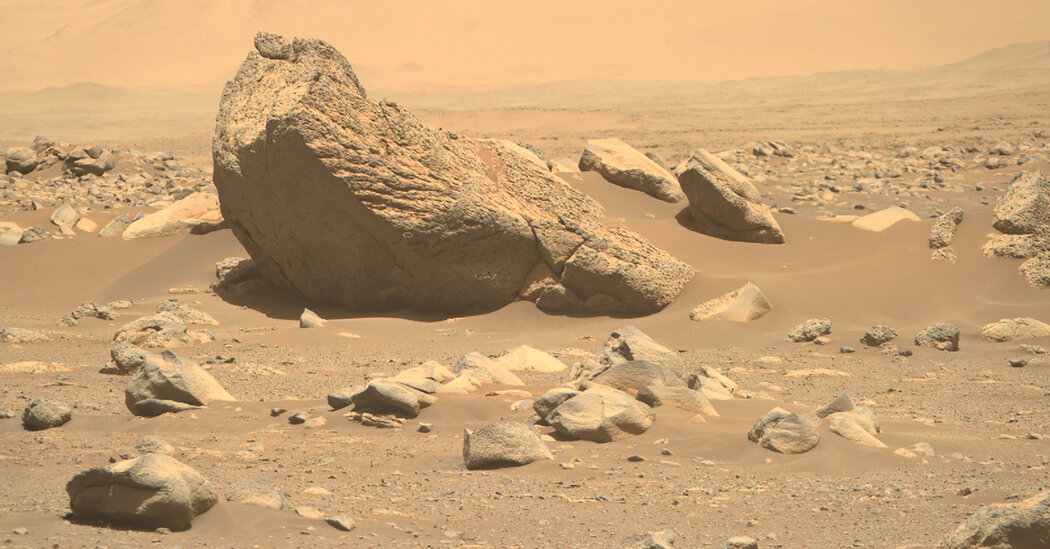A preponderance of boulder tracks on the red planet may be evidence of recent seismic activity.
If a rock falls on Mars, and no one is there to see it, does it leave a trace? Yes, and it’s a beautiful herringbone-like pattern, new research reveals. Scientists have now spotted thousands of tracks on the red planet created by tumbling boulders. Delicate chevron-shaped piles of Martian dust and sand frame the tracks, the team showed, and most fade over the course of a few years.
Rockfalls have been spotted elsewhere in the solar system, including on the moon and even a comet. But a big open question is the timing of these processes on other worlds — are they ongoing or did they predominantly occur in the past?
A study of these ephemeral features on Mars, published last month in Geophysical Research Letters, says that such boulder tracks can be used to pinpoint recent seismic activity on the red planet. This new evidence that Mars is a dynamic world runs contrary to the notion that all of the planet’s exciting geology happened much earlier, said Ingrid Daubar, a planetary scientist at Brown University who was not involved in the study. “For a long time, we thought that Mars was this cold, dead planet.”
To arrive at this finding, Vijayan, a planetary scientist at the Physical Research Laboratory in Ahmedabad, India who uses a single name, and his colleagues pored over thousands of images of Mars’s equatorial region. The imagery was captured from 2006 through 2020 by the High Resolution Imaging Science Experiment (HiRISE) camera onboard NASA’s Mars Reconnaissance Orbiter, and revealed details as small as 10 inches across.
“We can discriminate individual boulders,” Dr. Vijayan said.
The team manually searched for chain-like features — a telltale signature of a rock careening down an incline — on the sloped walls of impact craters. Dr. Vijayan and his collaborators spotted more than 4,500 such boulder tracks, the longest of which stretched over a mile and a half.
Sometimes the tracks change direction and occasionally new tracks suddenly branch off, Dr. Vijayan said. Such changing tracks are likely evidence that a boulder disintegrated mid-fall and that its offspring continued bouncing downslope.
Roughly one third of the tracks the researchers studied were absent in early images, meaning that they must have formed since 2006. The bounce marks of all of these young tracks are framed by a chevron-shaped pile of Martian regolith. That material, which Dr. Vijayan and his colleagues nicknamed “boulder fall ejecta,” is kicked out each time a boulder impacts the surface, the researchers propose.
And that boulder fall material is transient: By tracing the same tracks in images obtained at different times, the team found that boulder fall ejecta tends to remain visible for only about four to eight years. The researchers suggest that winds continuously sweeping over the surface of Mars redistribute dust and sand and erase the ejecta.
Because boulder fall ejecta fades so rapidly, seeing it implies that a boulder was dislodged recently, the team suggest. And a common cause of rockfalls, on Earth and elsewhere, is seismic activity.
Dr. Vijayan and his collaborators found that roughly 30 percent of the boulder tracks in their sample with boulder fall ejecta were concentrated in the Cerberus Fossae region of Mars. That’s far more than expected, the researchers say, since this region encompasses only 1 percent of the study’s area. “The surrounding craters have lots of boulder falls,” Dr. Vijayan said. “A few of them even have multiple falls in the same location.”
That makes sense, said Alfred McEwen, a planetary geologist at the University of Arizona and the principal investigator of HiRISE, not involved in the research. The geography near Cerberus Fossae, namely the Tharsis volcanic region, predisposes the area to seismic activity. “These giant masses of dense rock loaded up on the surface creates stresses throughout the surrounding crust of Mars,” Dr. McEwen said.
Since 2019, hundreds of marsquakes have been detected by NASA’s InSight lander, and two of the largest occurred last year in the Cerberus Fossae region.
In the future, Dr. Vijayan and his collaborators plan to extend their analysis to Mars’s polar regions. The HiRISE camera will hopefully oblige, Dr. McEwen said, despite the instrument being significantly past its design lifetime. “HiRISE is still going strong.”































